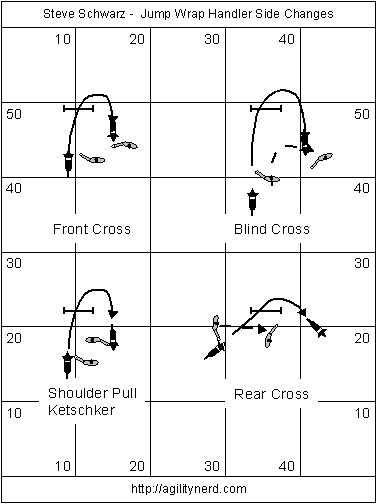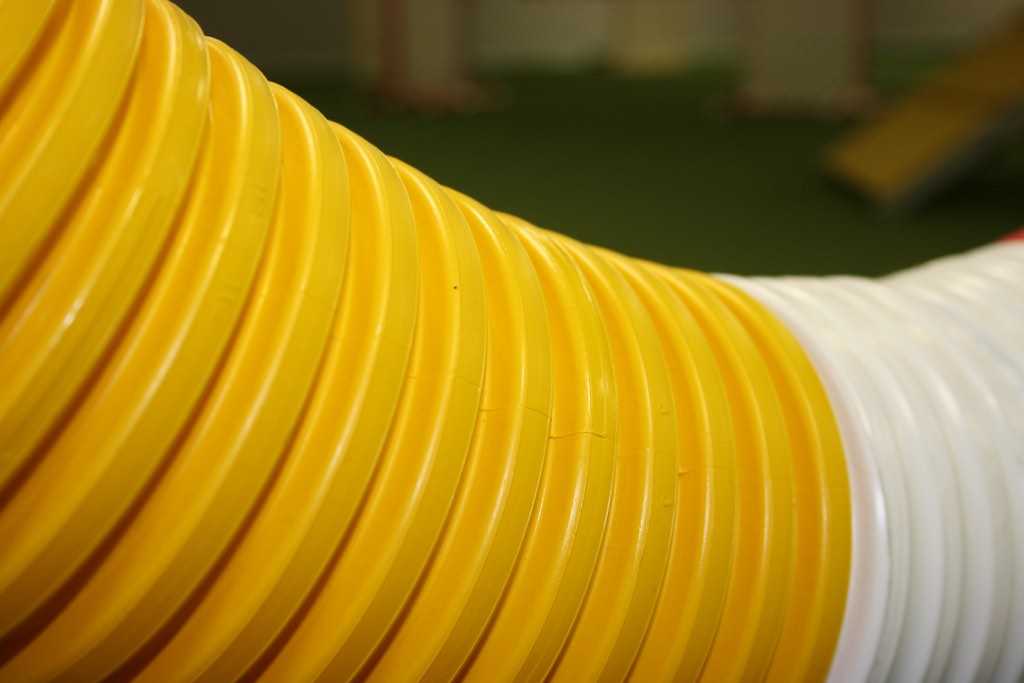Jump Wrap Handling Tips
31 Jan 2012
Here are some tips about jump wraps for my Mini Seminar: It’s a Wrap! - Fast & Tight Jump Wraps.
Types of Wraps
There are five main methods for executing a jump wrap: Shoulder Pull Learning the Post TurnPost Turn/Shoulder Pull/Pivot Turn, Front Cross Learning the Front Cross - VideoFront Cross, Rear Cross Learning the Rear CrossRear Cross, Ketschker, and Blind Cross. There are also variations on some of these:
- a send to the jump and then rotating could be called a shoulder pull but is sometimes called "throw and go". An RFP might be added to try to tighten up the dog's turn on it's way back to the handler.
- a quick handler (relative to the dog) can rear cross on the take off side and move in to a front cross to tighten the wrap and end up on the same side of the dog after the wrap.
For more details on jump wrap handling methods: see this article
Cuing the Wrap
As I always say: the dog needs to know where they are going next before they commit to the current obstacle. For a wrap the cues must be provided when the dog needs them; before it commits to the jump. You want the dog to take off for the jump already turning. In order to turn the dog has to collect some amount. Ideally the dog is kept in extension as long as possible and just prior to commitment to the jump the cues are given to ask the dog to collect and turn.
Handling a jump wrap is exactly like handling on other parts of a course. It requires identifying key control points on the course and weighing the handling options. Where will the dog and handler be in relation to one another at those control points and what cues could be applied to let the dog know where they are going next (and with how much collection - if any). In other words, will you be ahead of your dog at the jump wrap? Do you need a tight wrap (avoiding an off course or setting the line to the next obstacle)? Do you need to change sides as part of the jump wrap? What cues does your dog need in order to wrap as you need?
The tightness of the wrap really depends on using the cues your dog needs to understand collecting and turning at the jump. Some dog just require a change in motion (deceleration). A big, long striding dog who doesn’t like to collect may require every cue: deceleration, shoulders rotated toward the dog, an arm cue, eye contact and a verbal. It depends on your dog and your skills. Knowing how to use and combine the cues is the key to obtaining the amount of collection required for the desired tightness of the turn. Remember you may want a wider turn if it means your dog stays moving faster!
Some jump wrap handling techniques consistently give tighter wraps; because the handler applies more collection/turning cues. The Shoulder Pull and the Blind Cross tend to give more forward motion cues to the dog so they can cause wider jump wraps. The same is true for the Rear Cross although it depends more on the angle of approach to the jump and the amount of handler forward motion. The Front Cross and Ketschker use the most collection cues and generally give a tighter wrap but also require the handler be ahead of the dog.
Choosing How to Wrap
When choosing the handling for a wrap it helps to think about which side of your dog you want to be on after the wrap and whether or not you’ll be ahead of your dog at that jump.
| Cross | Change Sides | Ahead of Dog |
|---|---|---|
| Shoulder Pull |  |  * * |
| Front Cross |  |  |
| Rear Cross |  |  |
| Blind Cross** |  |  |
| Ketschker |  *** *** |  |
* If you “Throw and Go” you need not be ahead, being even will do.
** Due to all the forward motion cues the Blind Cross tends to give a wider wrap.
***The Ketschker is a little special. The handler rotates in to the dog on the approach, as though starting a Front Cross, and then sends the dog over the jump on the new inside arm. Then picks up the dog after the jump on the other arm (which was the arm on which they approached the jump). So the effect is the same as the Post Turn.
Here are some diagrams that show the side change, or not, when wrapping the dog to the right.

Getting Ahead
Getting ahead at a jump wrap requires cuing the wrap and trusting the dog to complete the wrap while the handler moves ahead. Most handlers “hang out” and babysit the dog taking the jump longer than the dog needs. That delay keeps the handler from taking at least one step away from the jump. The definition of “committing to the jump” is when the dog will no longer not take the jump. As soon as the dog is committed there is little reason to stay at the jump. Move on! Show motion to the next spot on the course.
The Throw and Go, Ketschker and Front Cross wraps can be cued “early” and the handler can leave for the next obstacle. It takes training, because, in the most extreme cases, the weaker cues are being used to support the dog taking the jump and have to make up for the stronger handler motion cue which is moving away from the jump.
Which Way to Wrap?
Choosing which direction to wrap is a topic for another post. There are two main approaches for choosing:
Shortest path/reducing lead changes:
- Which direction is the shortest path to the next obstacle.
- Does the dog change Lead to turn in one direction?
- Which direction is the shortest path to the next obstacle?
- Where are you coming from?
- Where are you going to?
I hope these quick notes on handling Jump Wraps are helpful. You might want to take a look at other articles and videos on the site about Jump Wraps for other details:
If you enjoyed this article won't you please:  Thanks!
Thanks!
